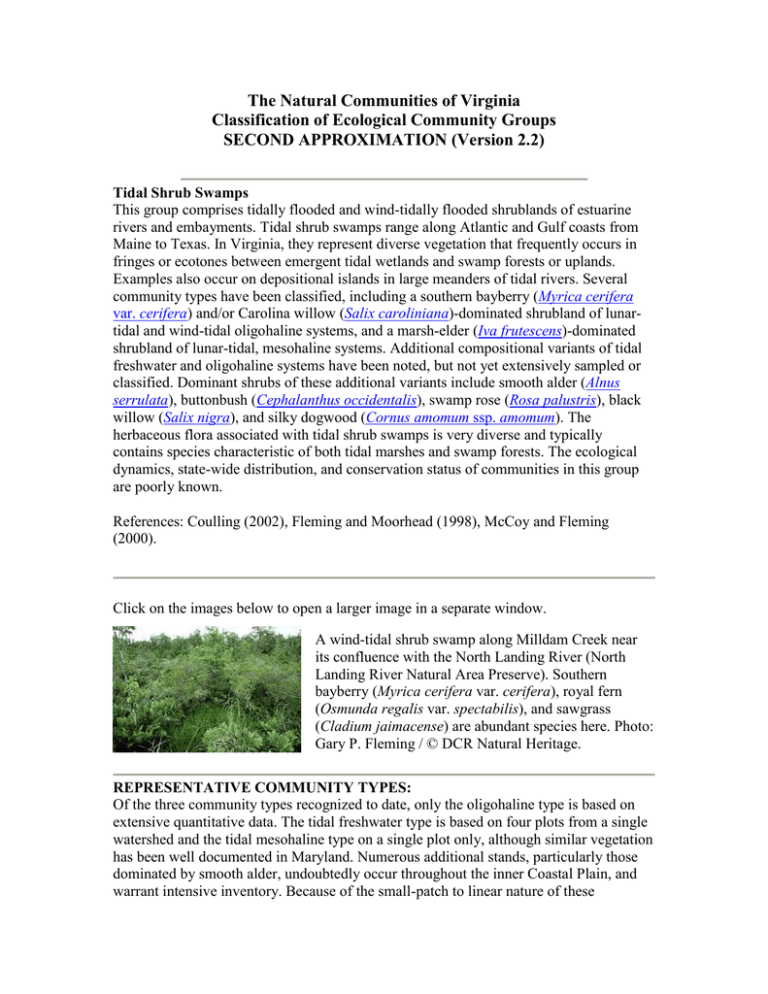The Natural Communities of Virginia Classification of Ecological Community Groups
advertisement

The Natural Communities of Virginia Classification of Ecological Community Groups SECOND APPROXIMATION (Version 2.2) Tidal Shrub Swamps This group comprises tidally flooded and wind-tidally flooded shrublands of estuarine rivers and embayments. Tidal shrub swamps range along Atlantic and Gulf coasts from Maine to Texas. In Virginia, they represent diverse vegetation that frequently occurs in fringes or ecotones between emergent tidal wetlands and swamp forests or uplands. Examples also occur on depositional islands in large meanders of tidal rivers. Several community types have been classified, including a southern bayberry (Myrica cerifera var. cerifera) and/or Carolina willow (Salix caroliniana)-dominated shrubland of lunartidal and wind-tidal oligohaline systems, and a marsh-elder (Iva frutescens)-dominated shrubland of lunar-tidal, mesohaline systems. Additional compositional variants of tidal freshwater and oligohaline systems have been noted, but not yet extensively sampled or classified. Dominant shrubs of these additional variants include smooth alder (Alnus serrulata), buttonbush (Cephalanthus occidentalis), swamp rose (Rosa palustris), black willow (Salix nigra), and silky dogwood (Cornus amomum ssp. amomum). The herbaceous flora associated with tidal shrub swamps is very diverse and typically contains species characteristic of both tidal marshes and swamp forests. The ecological dynamics, state-wide distribution, and conservation status of communities in this group are poorly known. References: Coulling (2002), Fleming and Moorhead (1998), McCoy and Fleming (2000). Click on the images below to open a larger image in a separate window. A wind-tidal shrub swamp along Milldam Creek near its confluence with the North Landing River (North Landing River Natural Area Preserve). Southern bayberry (Myrica cerifera var. cerifera), royal fern (Osmunda regalis var. spectabilis), and sawgrass (Cladium jaimacense) are abundant species here. Photo: Gary P. Fleming / © DCR Natural Heritage. REPRESENTATIVE COMMUNITY TYPES: Of the three community types recognized to date, only the oligohaline type is based on extensive quantitative data. The tidal freshwater type is based on four plots from a single watershed and the tidal mesohaline type on a single plot only, although similar vegetation has been well documented in Maryland. Numerous additional stands, particularly those dominated by smooth alder, undoubtedly occur throughout the inner Coastal Plain, and warrant intensive inventory. Because of the small-patch to linear nature of these communities and their proximity to both herbaceous-dominated marshes and more structurally complex swamp forests, standard plot sampling is often difficult. Click on any highlighted CEGL code below to view the global USNVC description provided by NatureServe Explorer. Alnus serrulata – Salix nigra / Pilea fontana Tidal Shrubland (PROVISIONAL) Tidal Freshwater Shrub Swamp (Smooth Alder – Black Willow Type) USNVC: = CEGL006337 Global/State Ranks: GNR/SNR Iva frutescens / Spartina patens Tidal Shrubland Tidal Mesohaline Shrub Swamp (Marsh-Elder / Saltmeadow Cordgrass Type) USNVC: = CEGL006847 Global/State Ranks: GNR/SNR Myrica cerifera – Salix caroliniana / Thelypteris palustris var. pubescens Tidal Shrubland Tidal Oligohaline Shrub Swamp (Southern Bayberry – Carolina Willow Type) USNVC: = CEGL004656 Global/State Ranks: G2G3/S2



